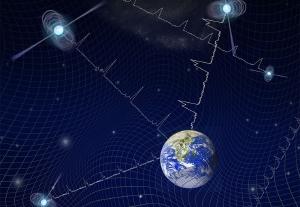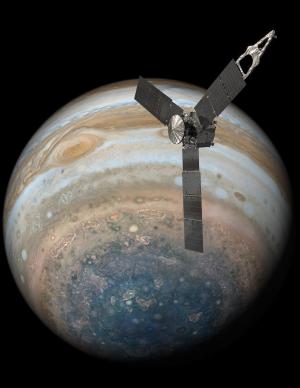Blog
Magnetic Messages
14 May 2023
 NANOGrav/T. Klein
NANOGrav/T. KleinOne of the challenges of gravitational wave astronomy is moving its abilities beyond observations of stellar mass mergers. The collision of two black holes or neutron stars releases a tremendous amount of gravitational energy, but even this is a challenge to detect. Gravitational waves do not couple strongly with most matter, so it takes a tremendous amount of sensitive observations to observe. But we are getting better at it, and there are a few proposals that hope to take our observations even further. One example of this is a recent study that looks at utilizing the magnetospheres of Earth and Jupiter.1
The observation of high-frequency gravitational waves is one of the holy grails of gravitational wave astronomy. According to the standard model of cosmology, these high-frequency waves should have been produced during the early period of the big bang, particularly as a result of the inflationary period. As such, they would provide detailed evidence of both early inflation and cosmic evolution. But at the moment these gravitational waves are too faint and random to be distinguished from background noise.
 NASA/JPL-Caltech
NASA/JPL-CaltechSo this new work looks at how they might be observed indirectly. Although high-frequency gravitational waves are faint, they do interact with the material they pass through, squeezing and flexing them ever so slightly. This is true not just for matter, but also for magnetic fields. When a gravitational wave passes through a magnetic field, the squeezing and flexing shift the magnetic field, which can produce photons. So the team wondered how this would occur when passing through fairly strong magnetic fields, such as the magnetospheres of Earth and Jupiter.
Both Earth and Jupiter have powerful magnetospheres. Earth’s magnetosphere is part of the reason we are protected from things such as solar flares. The team calculated the spectrum and intensity of photons that might be produced by Earth’s and Jupiter’s magnetospheres, and the results were encouraging. In fact, current Earth satellites could potentially capture some of these photons, as could the Juno spacecraft orbiting Jupiter. But since these spacecraft were never designed to observe such things, there’s no way for them to distinguish the signals from background radio noise.
But the study shows it could be possible to observe the effects of high-frequency gravitational waves. If we were to launch specially designed spacecraft into orbit around Earth and Jupiter, we should be able to detect gravitationally induced photons. What’s more, by combining observations from Earth and Jupiter, astronomers could also pinpoint the sources of the gravitational waves, since there would be a time delay from detection at Earth vs Jupiter.
This is an exciting time for gravitational wave astronomers. The field is still in its infancy, but it is quickly maturing. And studies such as this show we aren’t even close to the limits of what we may someday observe.
Liu, Tao, Jing Ren, and Chen Zhang. “Detecting High-Frequency Gravitational Waves in Planetary Magnetosphere.” arXiv preprint arXiv:2305.01832 (2023). ↩︎